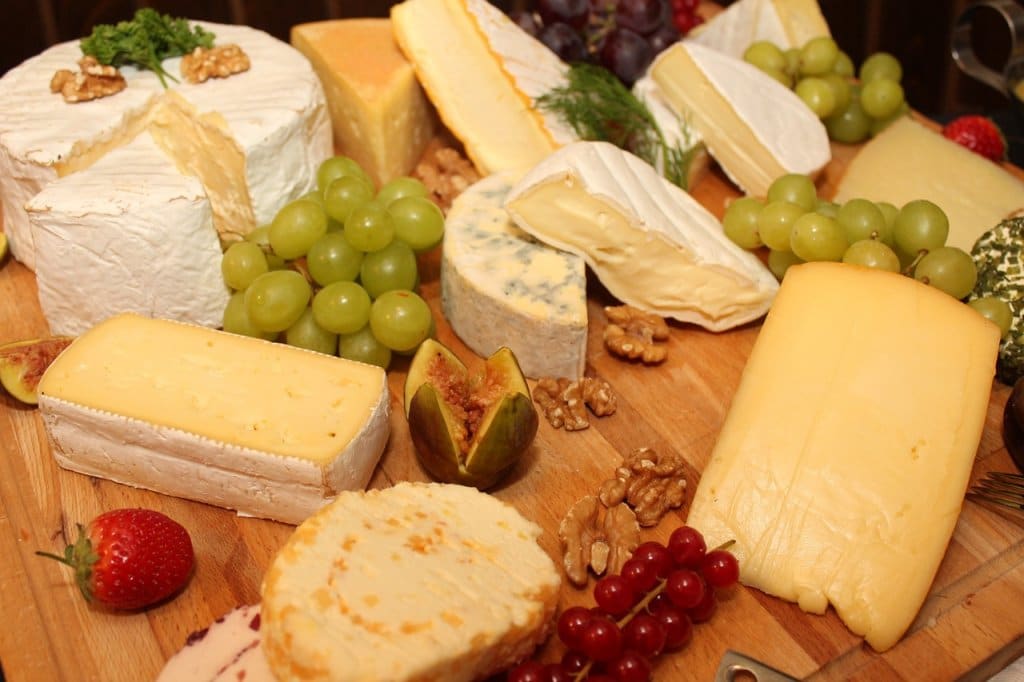
Can Cheese Be Part of Your Gout Diet?
When considering whether or not cheese is safe to eat with gout the first step — as with any food — is to check to see if it contains ingredients that may promote elevated uric acid (hyperuricemia), the root cause of gout.
The 2 main ingredients to look out for are purines and sugar, which we know can raise uric acid levels in the blood.
So, now, let’s take a close look at cheese and whether or not it’s safe to eat with gout…
How Cheese is Made
Cheese, basically, is curdled milk. The most common milk used is cow’s, but sheep and goat’s milk cheeses are very popular too, although any mammal’s milk can be turned into cheese.
The three basic ingredients used in the cheese making process are:
- Milk
- Cultures
- Rennet
1. Milk
Milk contains the fat soluble vitamins A, D, E, and K and small amounts of vitamin B6, vitamin C, folate, niacin, and pantothenic acid. It also contains casein and whey proteins, and is a good source of calcium, potassium, magnesium, selenium, zinc, and phosphorus.
Milk contains lactose (milk sugar) which could be problematical, but we’ll consider this later on.
2. Cultures
Cheese cultures are particular strains of good bacteria that are used to:
- develop acidity (which helps to expel moisture from the cheese curd), and…
- promote ripening (to help develop flavor, improve digestibility, and extend shelf life).
Cheese cultures increase milk acidity by converting the lactose sugar in milk into lactic acid which then helps to ripen the cheese. (This is important for gout sufferers as you’ll see later on.)
Most cultures today are produced commercially in either frozen or powdered form. Typically, just 1/2 teaspoon is used for 6-12 gallons of milk.
3. Rennet
Rennet is a complex set of enzymes produced in the stomachs of young plant-eating mammals such as calves, kids, and lambs, etc. The enzymes help to coagulate the milk in the youngster’s stomach so that they can get the maximum nutritional benefits from their mother’s milk.
These are known as “traditional” rennets, but there’s an increasing use of “vegetarian” rennets made from plants like the cardoon thistle, nettles, and artichokes, etc.
The role of rennet in the cheese making process is to coagulate the milk into solid curds (in much the same way as in the young animal’s stomach). The curds can then be separated from the liquid whey which can then be drained off. Typically, 1 kg of cheese contains about 0.0003 grams of rennet enzymes.
Rennet is commercially available in powder, tablet or liquid form and all work equally well.
In general, the manufacturing process consists of collecting and preparing the milk, separating the curds from the whey, pressing the curds, ageing, and wrapping the cheese.
Now let’s look at the purine and sugar content of cheese…
We just need to look at the milk alone since the rennet and cultures are added in such minute quantities compared to the volume of milk.
Purine Content of Cheese
Milk has a low purine content, i.e. less than 100 mg uric acid per 3.5 oz (100 g) serving. So, overall, cheese is low in purines and safe to eat as far as its purine content is concerned.
Sugar Content of Cheese
As we saw previously, milk contains lactose which is indeed a sugar. But the cheese cultures convert the lactose into lactic acid so that the lactose is now largely missing from the finished product.
So cheese is generally safe to eat with gout (as long as you are not lactose intolerant).
But, not only is cheese safe to add to your gout diet, several studies have linked milk and dairy produce, including cheese, to reduced uric acid levels and a lower risk of gout!
How Dairy Products, Incl. Cheese, Can Lower Your Risk of Gout
Although the exact mechanism isn’t precisely known, it’s believed that casein and whey proteins have an uricosuric effect on the kidneys, which increases uric acid excretion in the urine.
And the orotic acid in cow’s milk is thought to decrease the reabsorption of uric acid back into the bloodstream and so aid its removal through the kidneys.
In addition, calcium and lactose have also been linked to lower serum uric acid concentrations.
The net result of all this is to reduce uric acid levels and, therefore, the risk of gout attacks.
Full Fat v Low-Fat Cheese for Gout
Cheese’s fat content can be very high, depending on how it is processed. Luckily, most cheeses have low-fat versions on sale, and studies have shown that low-fat dairy products are equally as efficient in reducing your gout risk. So, if you’re on a low-fat diet, then you can go with low-fat cheese and dairy.



